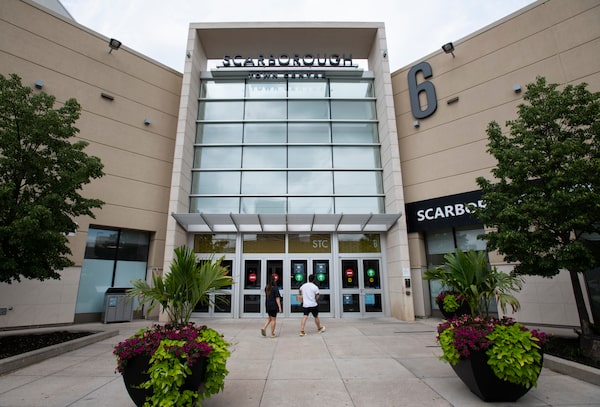As retailers begin to emerge from the pandemic’s doldrums, the future of shopping malls such as the Bay Centre in Victoria include welcoming more temporary-lease tenants.CHAD HIPOLITO/The Globe and Mail
They had not been to a mall in nearly a year, but on the first day that Scarborough Town Centre was permitted to reopen at the end of June, university students Areney Kamalavannan and Naome Karunakaran came for some retail therapy.
The result was a fairly modest haul – two small bags from Sephora and Lids – but the friends agreed it was refreshing just to be able to see what they were buying, and (praise be) to leave the house.
“I got fed up with online shopping,” Ms. Kamalavannan said.
After the nightmare of COVID-19, shoppers like these are a reason for hope for mall owners and retailers. But while industry watchers expect an exuberant return to in-person shopping, many malls are still facing longer-term headwinds once the novelty of those initial outings wears off.
Shoppers ride down an escalator in Sherway Gardens mall in Toronto during Ontario's Stage 2 reopening from COVID-19 restrictions on June 30, 2021.ALEX FILIPE/Reuters
Even before the pandemic slammed the retail industry, people were going to malls less often – including the top-tier ones that generate the most revenue per square foot. In 2019, foot traffic at Canada’s top 10 malls fell by 22 per cent compared with the previous year, according to Deloitte.
“Short term, malls will do quite well. We’re expecting one of the best back-to-school environments that we’ve ever seen … and the Christmas season is also expected to be very strong this year,” said Corrado Russo, senior managing director with Hazelview Investments, a global investment manager focused on real estate. “But once we get past that, all of the challenges that malls have had over the last five and 10 years are still there.”
The future of shopping in malls post-pandemic society are welcoming more temporary-lease tenants which can range from one to three year leases instead of five to 10 years which was typical. Scenes from the Bay Centre in Victoria, Wednesday, June 30, 2021.Chad Hipolito/The Globe and Mail
Those challenges include the declining popularity of department stores, the rise in online shopping and a contraction in fashion retail that once filled many mall spaces. Vacancies during the pandemic did not balloon as much as landlords feared at the beginning – largely because of government support.
Still, 2,026 stores in Canada closed in 2020, more than three times the prior year’s number, according to global commercial real estate giant Cushman & Wakefield. That was led by Starbucks and David’s Tea, but also included many mall stalwarts that either pared down their number of locations – such as Aldo, Bizou, Bouclair, Ricki’s and Stokes – or decided to close altogether, such as Carlton Cards and Addition Elle.
Now, as mall owners begin to emerge from the pandemic’s doldrums, they are rethinking how to use their space, and landlords and retailers are working to evolve the shopping experience to keep people coming back.
“The pandemic has just accelerated those conversations surrounding the right tenant mix, how to attract people to the mall, what we should do with the actual physical real estate … [and] offerings in the mall that better accommodate for e-commerce,” said Hani Abdelkader, a principal with commercial real estate services firm Avison Young in Calgary. “COVID has accelerated the urgency to adopt these things.”
How retail is bouncing back from COVID-19
Many shoppers are sitting on disposable incomes that went undisposed during months of curtailed vacations and evenings out. For the fortunate whose employment was not affected by the pandemic, it is a windfall borne of boredom. Canadians socked away more than $200-billion in savings last year, according to Statistics Canada.
Not all of that will flow back into retail. But there are some opportunities in all that pent-up demand, such as fashion retailers courting customers whose wardrobes have not been refreshed in months.

Scarborough Town Centre in Toronto reopened at the end of June as Ontario gradually rolled back its COVID-19 restrictions.Fred Lum/The Globe and Mail
“Where we have been opened the longest with lesser restrictions, we are getting sales that are in the order of 70 to 80 per cent, and in some cases 90 per cent, of what they were prepandemic,” said Sal Iacono, executive vice-president of operations with mall owner Cadillac Fairview.
However, some believe shoppers are coming back to malls with a different mindset – less tolerant of nuisances such as long checkout lines, hunting for parking and waiting for assistance.
“The in-store experience has to be more frictionless,” said Mark Penn, chairman and chief executive of marketing firm MDC Partners and chairman of Harris Poll, which has been surveying consumers during the pandemic.
Ivanhoé Cambridge is trying to address this, speaking with its tenants to find out which “pain points” need solving to keep attracting shoppers.
Solutions for pandemic problems could be part of a longer-term strategy. For example, in response to COVID-related capacity restrictions, many malls introduced digital line-management tools to let shoppers know when it was their turn to go into a store without making them physically stand in line. Those could now be repurposed to reduce the irritation of busy checkouts. Oxford Properties is currently looking at digital tools to allow people to reserve parking stalls before coming to its malls.
“We believe in malls, certainly,” said François Lacoursière, Ivanhoé Cambridge’s senior vice-president of innovation. “But of course, we need to change.”
Do local retailers have a place in malls?
The pandemic ignited a shop-local movement, but for most people looking to support small businesses, the mall is likely not the first place that comes to mind.
That’s because mall landlords have typically preferred long-term lease deals – five to 10 years in general – that independent shops may not be able to commit to. But as COVID-19 has opened up more space in malls, and more owners are looking at the right tenant mix to attract shoppers, more flexible leases are attracting a new crop of retailers.
Canadian retailers, restaurants offer perks to lure workers in hot job market
Victoria-based jewellery maker and designer Cory Judge is one of those. The trade shows she relied on were cancelled early in the pandemic. “My entire livelihood just disappeared in a puff of smoke,” Ms. Judge said. So she decided to open a store.
Ms. Judge teamed up with two friends who were also small business owners – a glassblower and the owner of a farmers’ market. The idea was to carry products from other Canadian artisans, including handmade cutting boards, jam, art, T-shirts and candles.
But when the trio went looking for a space, most landlords did not want to risk a short-term lease. The Bay Centre, a mall managed by Cushman & Wakefield, was an exception. The Victoria Market Collective opened there in October.
“We did a four-month lease to begin, which is unheard of usually,” Ms. Judge said. They then renewed for another year.
Market Collective co-creators from left to right, Katrina Dwulit, Vanessa Gaudet and Cory Judge are photographed inside their store which is a space for handmade artisans representing local makers at the Bay Centre in Victoria.Chad Hipolito/The Globe and Mail
While pop-up shops are nothing new, these kinds of flexible leases are becoming more common in malls.
“When you’ve got this uptick in vacancies, [owners] become more receptive to the risk associated with these temporary tenants,” said John Crombie, executive managing director of retail services in Canada for Cushman & Wakefield. The company has recently done deals with many small retailers, including a seller of electric bikes, a custom perfume maker and specialty food shops.
Tenant mix was already shifting before COVID-19: Non-retail spaces grew from 27.3 per cent of mall space in 2015 to 34.3 in 2020, according to the International Council of Shopping Centers, a trade association that announced a rebranding this week and will be renamed Innovating Commerce Serving Communities. Owners have repurposed retail spaces to open more food and beverage options, fitness centres, educational spaces, health care and other services – a trend that is expected to continue.
“Most landlords, if you look at their malls, 5 per cent or less of the [gross leasable area] is devoted to alternative uses,” said Sherif Masood, Oxford’s vice-president of national asset management, retail. “Our goal is to get that up to 10 per cent in the next few years.”
Events, entertainment pop-ups and other attractions have also taken on new importance. Oxford is currently in talks with a company that did a Dr. Seuss exhibition prior to COVID-19 to do more events at its malls. Such attractions draw people from a wider geographical range, Mr. Masood said.
During the pandemic, Oxford also repurposed parking lot space across Canada, creating outdoor patios to provide comfortable social spaces for guests and to support food and beverage tenants inside the mall who were hurting. At Scarborough Town Centre, the company held a “Street Eats” festival with food trucks.
“A lot of the concepts will be here to stay,” Mr. Masood said.
Wooing new shoppers from Amazon to the mall
The concept of the mall originated in convenience. But that one-stop shop has been supplanted to some extent, by the likes of Amazon.com Inc. During months stuck at home, even more Canadian shoppers have now built up an e-commerce habit.
According to research firm eMarketer, e-commerce sales in Canada jumped by a whopping 75 per cent last year to $77.25-billion. That research predicts that even after the pandemic jump, e-commerce’s share of the overall retail market will continue to rise.
That is not to say that stores are dead. But while most people do intend to go back to bricks-and-mortar shopping, 60 per cent of Canadians surveyed by Harris Poll said they expect to continue to shop online as well. Those “blended” shoppers expect better digital services both online and in stores.
Roots Corp. launched virtual shopping appointments in April, 2020, connecting customers with store associates by phone, live chat and video while Roots locations – many of them in malls – were closed. Some staff have now been permanently moved into that function, and while the company is expecting fewer virtual appointments as customers come back to stores, it is considering how to continue merging online shopping with in-person service.
“It’s really about taking that next step. If you have a buy-online-pick-up-in-store customer, do you call them and say, ‘Are you coming in tomorrow? I’m going to set up a change room so that you can try things on,’” Roots CEO Meghan Roach said. “We’re definitely having those conversations about how to evolve things.”

People stop by one of the food vendors at the Street Eats Market, set up across the road from the Scarborough Town Centre in Toronto, on June 30, 2021.Fred Lum/The Globe and Mail
Montreal-based Salesfloor has a mobile application for store associates to shop live online with customers, and has seen its customer base grow by 67 per cent in the past year.
“Even though traffic is definitely going to bounce back, you probably will see a drop of about 15 per cent in traffic that just won’t come back, because customers now are more comfortable than ever purchasing online,” Salesfloor co-founder Oscar Sachs said.
Some malls are also using digital tools to bring shoppers back. “We’re launching a bunch of [promotions] this summer – come to the mall three times and get rewarded,” said Matt Crowell, founder and CEO of Kelowna, B.C.-based GetintheLoop, a digital marketing firm that does localized promotional offers for large and small retailers.
Malls also want to be part of the e-commerce ecosystem. After retailers repurposed some mall locations as “dark stores” to fill online orders during the pandemic, many mall owners are looking into building their own microfulfilment centres.
“We can help with [delivery] logistics, help on returns and also have last-mile capacity,” said Mr. Lacoursière of Ivanhoé Cambridge.
Some malls are working to improve services for people who buy online and want to pick up or return items in stores. Cadillac Fairview has started a pilot with a service called ReturnBear, offering centralized product returns for multiple retailers.
“In the long term, the holy grail we’re trying to work toward is the one-basket approach,” Oxford’s Mr. Masood said. “Wouldn’t it be cool if you can go online, buy from four or five different stores and then swing by the mall in one spot and pick them all up?”
“We have to make the customer’s journey more seamless,” he said. “Give people a reason to get off the couch.”
Your time is valuable. Have the Top Business Headlines newsletter conveniently delivered to your inbox in the morning or evening. Sign up today.
 Susan Krashinsky Robertson
Susan Krashinsky Robertson